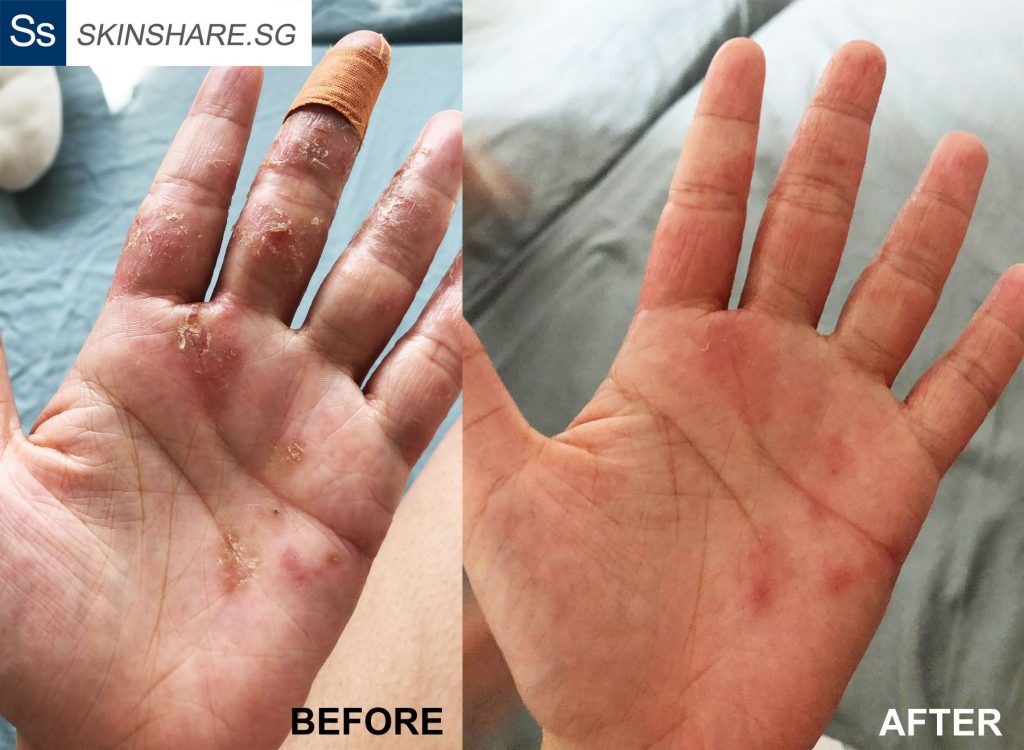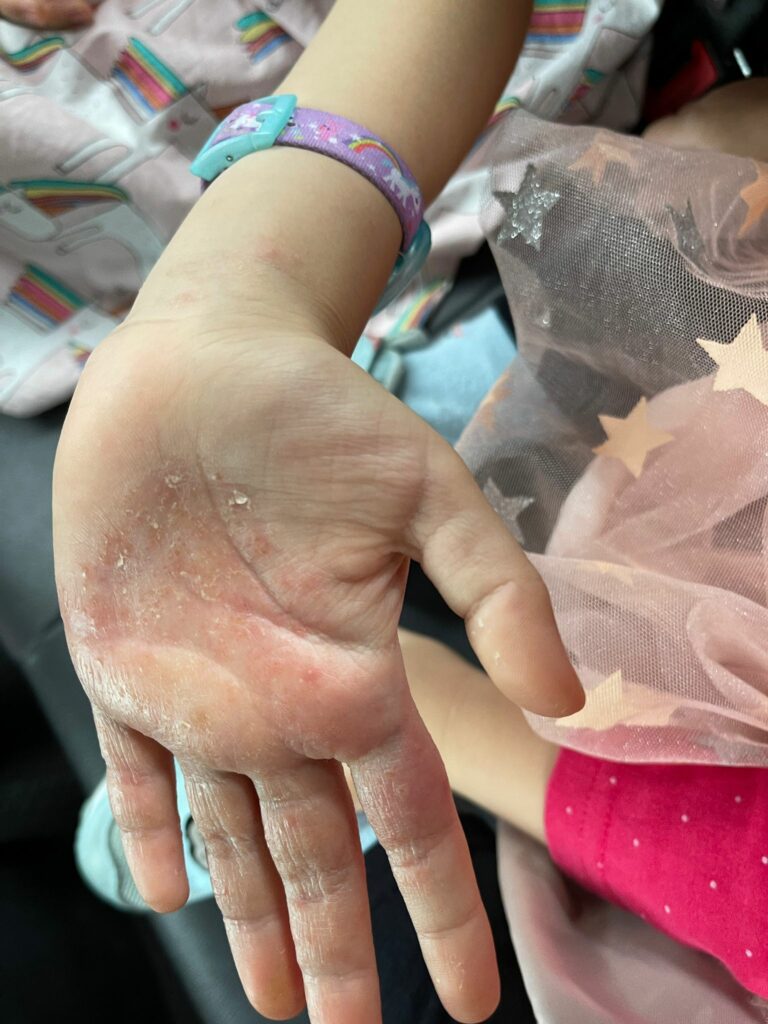Discussion
The most common types of eczema in Singapore and how to recognize them
According to a study carried out in 2015, 21 percent of children and 11 percent of adults in Singapore have eczema, and half of them have this condition for life.
In other words, 1 in 10 adults and 2 in 10 children have developed eczema in Singapore. That’s a lot of people!
The actual cause of eczema is not fully understood, but it is believed that people who have eczema also have a highly reactive immune system. When the skin is triggered, it can become inflamed and flare up.
The hot and humid weather is one of the most common external trigger factors for a flare-up, as well as dusty environment, irritant chemicals, and sweat.
Eczema can appear on different parts of the body. The most common being the neck, arm folds, legs and hands. It can also look different from person to person.
There are different types of eczema, but all of them cause itching. You may also have more than one type of eczema on your body at once. Depending on the type of eczema you have, you may need to treat it differently.
Here are a few common types of eczema in Singapore; where on the body they usually occur; and what they might look like:
Atopic eczema
Atopic eczema is also known as atopic dermatitis. This chronic skin disease causes inflammation and itchiness. It is often caused by environmental factors such as allergens, irritants, and other triggers.
People with atopic eczema tend to experience the “itch-scratch cycle”. When they itch, they scratch, and this causes the area to feel even more itchy, thus the cycle repeats. The itch cycle begins with the activation of nerve endings in the skin by an allergen or other trigger. This sets off a series of events that lead to itching and, if scratched, redness and swelling. The cycle can be broken by avoiding the trigger and using topical treatments to reduce symptoms.
Alina, a nurse in Singapore, experienced postpartum eczema that can be described as atopic dermatitis. “Since my second pregnancy, my whole body had a flare-up. My dermatologist recommended me starting back on steroids, but I was reluctant to”.
She gradually got her skin under control 19 days after following our recommendations.

Contact dermatitis
Contact dermatitis is a type of skin inflammation that is caused by contact with an irritant, or even through indirect effects, such as pressure from a handbag strap or wedding ring.
One common type of irritant is a chemical irritant. Chemical irritants are usually found in things like soaps and detergents and they can lead to allergic reactions or contact dermatitis if they come into direct contact with the skin. For example, many people have found that they are allergic to the preservatives in toiletries, such as methylisothiazolinone.
The second type of irritant is a physical or mechanical one, such as excessive heat or cold exposure, friction, and pressure. For example, some people experience an eczema rash when wearing poorly-fitting shoes, or if they stay in an air-conditioned office for too long.
Kendra, a mum in Singapore, experienced painful cracked skin on her hands after returning from holiday. She explained that during the trip, she had to use the hotel soap to bathe her kids. This was the most likely trigger for her contact dermatitis. “I didn’t have any eczema reaction to our soap at home. But we were on a trip, so I had to use the outside soap,” she explained.
After incorporating our moisturiser and shielding lotion into her care routine, her hands gradually got better. “The wounds closed up, and there is no more dryness or tightness,” she said.

Neurodermatitis
Neurodermatitis is characterised by the appearance of a dark patch of rough, leathery skin. The patch feels and looks scaly and harder than other areas, and is formed due to continuous scratching. This can appear on the neck, forearms, legs, or wrists.
Even though the skin on the affected area appears leathery and scaly, it remains highly sensitive and can trigger intense itching, which leads to more scratching and potential infection.
Dyshidrotic eczema
Dyshidrotic eczema appears as small blisters, usually on the palms of hands, near the bottom of the feet, or on the fingers and toes. These blisters are itchy and painful, and if scratched, they can pop and leak pus or clear liquid.
As the blisters heal, the area of skin can become red, start peeling or flaking, or become cracked. As such, the person is at greater risk of infection.
Sara came to us with the problem above, which was affecting her daughter. She said, “it got to the point where the palms of her hands were covered in blisters, with red and itchy skin. She couldn’t sleep and had trouble concentrating on her music and studies.”
One of the remedies we suggested was to wear bamboo eczema gloves to sleep at night. Wearing gloves at night can reduce unconscious scratching at night, preventing the skin from further damage. Three weeks later, Sara told us that her daughter’s hands were much better, and that she could perform again.

Nummular eczema / Discoid eczema
Nummular eczema is similar to atopic dermatitis, but it shows up as distinct round, coin-shaped spots on the skin, often on the arms, hands, legs, and torso. These spots can be itchy and sometimes become scaly patches. The patches can be intensely itchy and may ooze fluid. Sometimes, the centre of the patch may clear up, leaving a ring of discoloured skin.
Treatment for discoid eczema is generally the same as for atopic dermatitis; keep the skin hydrated, reduce inflammation, and avoid infection. In some cases, antihistamines are prescribed to reduce itching.

Seborrheic dermatitis
Commonly found on the scalp, face, and chest, this eczema causes red, scaly, itchy patches. The exact cause of seborrheic dermatitis is unknown, but it may be related to a yeast (fungus) called Malassezia that is in the oil secretion on the skin, an irregular response of the immune system, or genetic factors.
Treatment could include antifungal products, medicated shampoos for the scalp, and topical antifungal or anti-inflammatory agents. For mild cases, daily cleansing with a gentle soap and shampoo can help reduce oiliness and dead skin buildup.
Infants may also experience seborrheic dermatitis. also known as cradle cap. In such cases, it should clear up on its own, or with gentle shampooing.

Stasis dermatitis
This condition mainly affects the elderly who have poor circulation. Perhaps they are in a wheelchair, or bedridden, and blood flow is affected. It usually affects the lower legs, and might start with a slight reddening of the skin, progressing to brownish discoloration, accompanied by swelling, itching, and sometimes pain.
These symptoms were observed during a study of homes for the aged in Singapore. Creams and ointments are not helpful in such cases, therefore compressive bandages or elastic stockings are more effective.
General care and treatment
From the list above, you can see that each type of eczema has its unique triggers and symptoms. Therefore, recognizing your specific type of eczema is crucial for better management.
However, a general approach to caring for eczema is to keep the skin clean, moisturised, and protected from irritants.
Skinshare.sg offers a curated selection of products that have been effective at controlling eczema. These products address one or more of the five key steps to manage eczema flare-ups, and should be incorporated into your care regimen.
